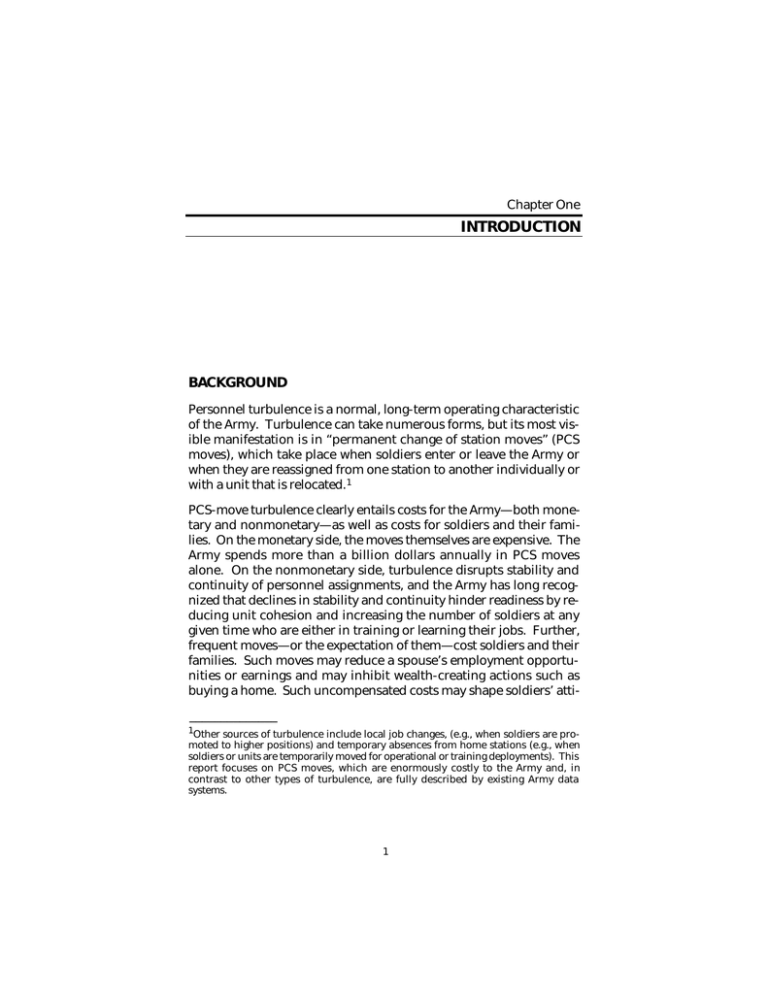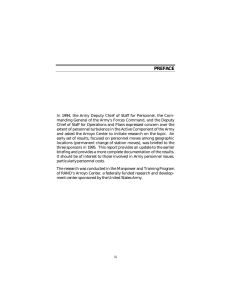INTRODUCTION BACKGROUND
advertisement

Chapter One INTRODUCTION BACKGROUND Personnel turbulence is a normal, long-term operating characteristic of the Army. Turbulence can take numerous forms, but its most visible manifestation is in “permanent change of station moves” (PCS moves), which take place when soldiers enter or leave the Army or when they are reassigned from one station to another individually or with a unit that is relocated. 1 PCS-move turbulence clearly entails costs for the Army—both monetary and nonmonetary—as well as costs for soldiers and their families. On the monetary side, the moves themselves are expensive. The Army spends more than a billion dollars annually in PCS moves alone. On the nonmonetary side, turbulence disrupts stability and continuity of personnel assignments, and the Army has long recognized that declines in stability and continuity hinder readiness by reducing unit cohesion and increasing the number of soldiers at any given time who are either in training or learning their jobs. Further, frequent moves—or the expectation of them—cost soldiers and their families. Such moves may reduce a spouse’s employment opportunities or earnings and may inhibit wealth-creating actions such as buying a home. Such uncompensated costs may shape soldiers’ atti______________ 1 Other sources of turbulence include local job changes, (e.g., when soldiers are pro- moted to higher positions) and temporary absences from home stations (e.g., when soldiers or units are temporarily moved for operational or training deployments). This report focuses on PCS moves, which are enormously costly to the Army and, in contrast to other types of turbulence, are fully described by existing Army data systems. 1 2 Personnel Turbulence: The Policy Determinants of PCS Moves tudes toward the Army, which may, in turn, lead to greater attrition; increased attrition may lead to declines in unit cohesion and, in turn, to declines in readiness. This research seeks to determine the extent and policy determinants of PCS moves, in the recent past and in the future, and to propose a range of alternative policies the Army could pursue to reduce instability and hold down costs, and by so doing, perhaps enhance cohesion and readiness. APPROACH To help assess policy options for dealing with the turbulence associated with PCS moves, this research relies upon a highly aggregated, spreadsheet-based model of the PCS process. The model estimates flows among the various locations (or venues) to which the Army assigns soldiers. More specifically, the model takes as input characteristics for each venue the following parameters: the venue’s authorized strength, the tour length associated with the venue, and the time required to make the move from one venue to another. It provides the following outputs: the detailed assignment flows into and out of each venue and the tour length associated with CONUS TOE assignments. Our simulation ignores training, unit, and certain classes of operational moves. Together, the omitted moves constitute about 10 percent of the actual totals. ASSUMPTIONS The research in this report is based on the following fundamental assumptions: • The Army leadership desires to enhance assignment stability and reduce the deleterious effects of turbulence in ways consistent with its other imperatives. • The Army will enter a postdrawdown phase in which its end strength will remain fairly constant at under 500,000 Active Component (AC) soldiers. Introduction 3 • For the near-to-mid term, the Army will continue to station a substantial fraction of its force overseas and will maintain for the foreseeable future the post–Base Realignment and Closure (BRAC) basing structure it now has planned. • The Army’s fundamental manpower policies pertaining to acquiring, training, and separating soldiers will remain intact. In subsequent chapters we shall use the model to test how sensitive our findings are to changes in certain of these assumptions. ORGANIZATION OF THIS DOCUMENT Chapter Two examines the extent of the Army’s recent (since 1987) and projected (through 2003) PCS-move experience in terms of number of moves by type and in terms of costs; it then explores the relationship between the extent of that turbulence and the policies and external conditions that drive it. Based on this understanding of what drives PCS moves, in Chapter Three we use the model described above to estimate the effects of policy changes on turbulence. Chapter Four offers conclusions.


